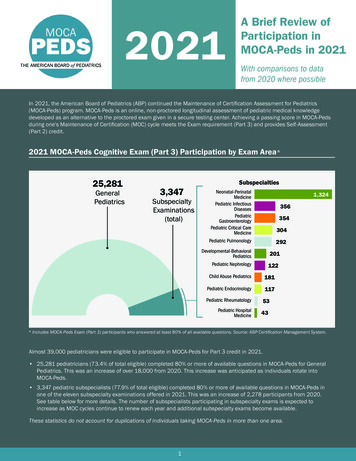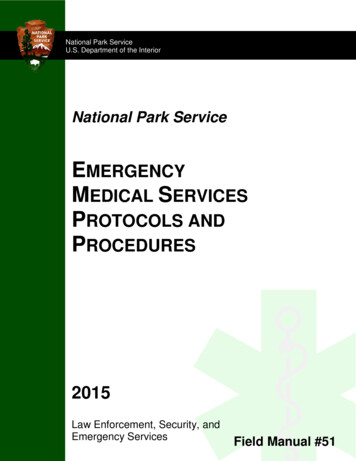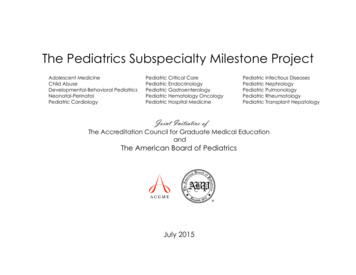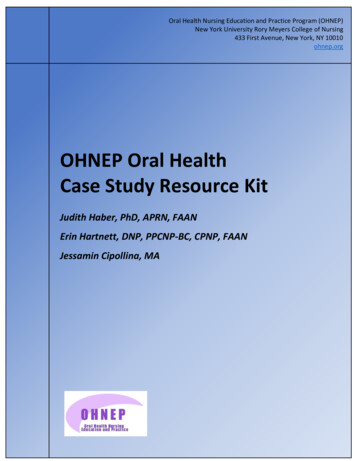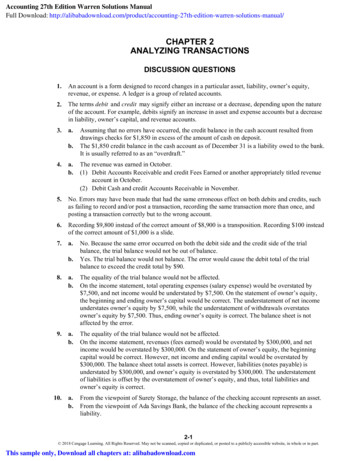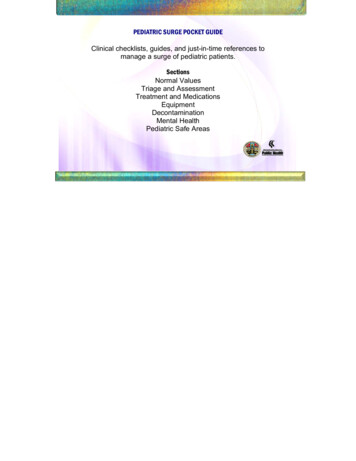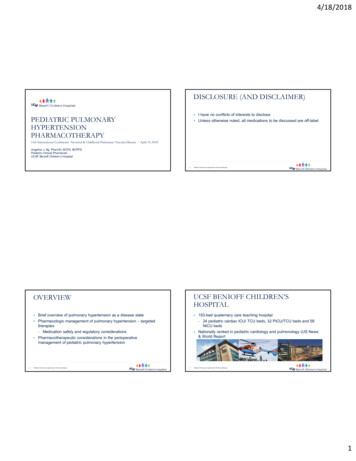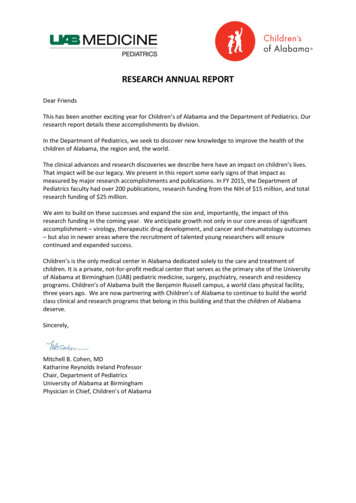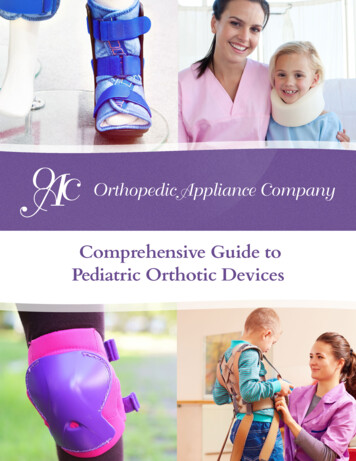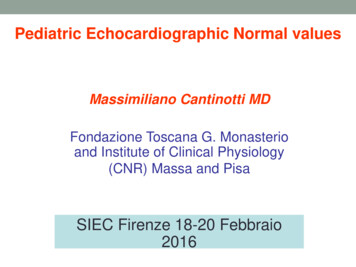
Transcription
Pediatric Echocardiographic Normal valuesMassimiliano Cantinotti MDFondazione Toscana G. Monasterioand Institute of Clinical Physiology(CNR) Massa and PisaSIEC Firenze 18-20 Febbraio2016
Background An echocardiographic quantitative evaluation ofthe cardiac and vascular structures is often ofcritical importance for the diagnosis andmanagement of congenital heart diseases. In the pediatric age echocardiographicmeasurements, as well as any othermeasurements, need to be normalized accordingto range of normality for a given age and bodysize.
How To Normalize In the pediatric age data are commonlynormalized according to: Age Weight/height BSA BSA usually adopted for normalization inpediatric echocardiography
How to express normalized data: Zscores Normalized data may be expressed in differentways, including the percentage of the meannormal value, percentile charts, and Z scores. The Z score of a measurement is the number ofstandard deviations of that value from the meanvalue. If a measurement is equal to the populationmean, the Z score is 0; a Z score of 2 or 2 correspondsto the 95th percentile (i.e., 2 standarddeviations above or below the mean)
Nomograms and Z scores Thus to normalize in pediatricechocardiography we use nomograms Normalized data are expressed as z score i.e. a z score 2 indicate dilatation while az score 2 indicate hypoplasia
To trust in z scores? Clinician often rely on z score to take veryimportant clinical decision (i.e. biventricularversus single ventricle repair) Thus z scores should be accurate tools BUT .
PART 1: dimensional Indexes Basically 2d values
Parameterz.com
c
Structures evaluatedWe evaluated 31 published nomograms on 2 cardiac dimensions: LVED and LVES diameters in M-mode; MV annulus in apical 4CH-view and PLA view and the TV annulus inthe apical 4CH-view; Pulmonary annulus, MPA, and pulmonary arteries in theparasternal SA view; Aorta: AO annulus, the AO root at the sinuses of Valsalva, thesinotubular junction, and the ascending aorta in the PLA view; AO Arch at different levels: the proximal transverse arch (betweenthe IA and LCA), the distal transverse arch (LCA and LSA) and theaortic isthmus (narrowest aortic segment distal to LSA).
RESULTS The analysis highlights the accuracy of thelatest studies but also underscores thatsome limitations remain. 2 major Limitations Numerical Methodological
Methodological Limitations the lack of standardization in echomeasurements (ASE guidelines onlyrecently available) the different types of body sizemeasurements used for normalization(BSA, weight, height) the various ways to express normalizeddata.
Numerical limitations The number of healthy subjects waslimited Poor differentiation among age subgroups Neonates poorly investigated Data for many cardiac structures were notnumerous, especially for the aortic arch andpulmonary branches.
Echo measurements For a long period of time it was not clearwhich moment of the cardiac cycle toemploy for measurements ASE guidelines only recently available 2D valvular and vessels diameters shouldbe measured at the moment of maximumexpansion (Ped Guidelines not Adult)
Confounders Potential confounders have scarcelyevaluated Gender and race differences Interobserver and intra-observer variability Neonates: factor related to delivery
A huge heterogeneicity inestimation of the CHDCase: A male child with a BSA of 0.3 m2 MV annulus of 11 mmsignificantly different results can be obtained accordingto the nomogram used,from lower limits of normality (-1.63) up to a clearhypoplasia of -4.84.
Nomograms for LV diameters: ExampleBSA 0.3 m2
Nomograms for AV valves: Example BSA0.3 m2
Parameterz.com
Conclusions The lack of valid nomograms based on a robustset of healthy children, using standardizedapproaches and formulas, substantially affectsaccuracy in estimating the severity of defects,especially in neonates. Despite advances, the process of normalizationof pediatric echocardiographic measures is stillincomplete. Indeed, differences between availablenomograms may generate Z scores largelydiscordant for a given measurement.
Structures evaluated 22 cadiac structures LVED and LVES diameters in M-mode; MV annulus in apical 4CH-view and PLA viewand the TV annulus in the apical 4CH-view; Pulmonary annulus, MPA, and pulmonaryarteries in the parasternal SA view; Aorta: AO annulus, the AO root at the sinuses ofValsalva, the sinotubular junction, and theascending aorta in the PLA view; AO Arch at different levels Ase Reccomendations (2010)
Key points in the building of a zscore. To measure in a reproducible,standardized method To use a rigorous statistical methods The choice of the parameter to be used fornormalization Sample size Attention to confounders
How to measure?
Atrio-ventricular valve measurement
Semilunar valve measurement
Aorta and Aortic arch measurement
Statistical Methods Models using logarithmic, exponential,and square root relationship tested Independent variables used to normalize:age, weight, height and BSA Seven BSA formulas employed(Haycock, DuBois, Mosteller, Dreyer,Meban, Boyd, Gehan) Heteroscedasticity tested by White testand Breusch-Pagan Test
How to express normalizedmeasurements: BSA issues BSA, weight, height, age BSA today accepted However, some mathematical limitations inthe use of BSA still persist, including adependence of BSA-adjustedmeasurements on BSA and high variabilityof results according to the formula used,particularly for lower height and weight.
BSA formula 7 Formulas The DuBois formula most used, but it has beenrecently challenged by the Haycock formula. The DuBois formula in particular tends toincreasingly underestimate for BSAs 0.7 m2compared with the Haycock formula. A similar problem of underestimation at low BSAvalues has also been observed for other formulas.
Population 448 Italian healthy subjects Age range 0 days -36 months 49% Female
Results The Haycock formula provided the bestresults DuBois, Mosteller, Deryer and Mebanunderstimated Boyd and Gehan overstimated The Haicock formula used whenpresenting data as predicted values (mean SD)
Regression equations
Population
Comparison with other nomograms BSA 0.3 m2
Conclusions We report new, reliable echocardiography Zscores derived from a large population ofCaucasian neonates, infants and toddlerscalculated using a rigorous statistical design Our nomograms represent a valid diagnostic toolfor echo quantification in this age group Further studies are required to evaluate otherparameters as well as the effects of race andethnicity on reference values.
2D Nomograms Pettersen 0-18 yrs and Cantinotti 0-3 yrsacceptable Not all 2D measures covered, in partciularchamber area and diameters lacking (onlyM-mode)
Echocardiographic nomograms for chamber diameters and areasin Caucasian children. A total of 1,091 Caucasian Italian healthy children (agerange, 0 days to 17 years; 44.8% female) with body surfaceareas (BSAs) ranging from 0.12 to 1.8 m(2) wereprospectively enrolled. Echocardiographic reference values are presented forchamber area and diameters, derived from a largepopulation of healthy children. These data partly cover a gap in actual pediatricechocardiographic nomograms. Further studies are required to reinforce these data, aswell as to evaluate other parameters and ethnicities.
New parameterz.com
PART 2: Functional Indexes Diastolic values Deformation indexes Others
Diastolic function
Materials and Methods Mitral and Tricuspid Inflow: E wave, the E/A ratio, DT,IVRT Mitral Velocities e' and a'; Tei index for LV and RV 33 studies evaluating diastolic function in children wereincluded in this review.
Methodological Limitations There was significant heterogeneity in the methodologies to perform andnormalize measurements and to express normalized data (Z-scores,percentiles, and mean values). Although most studies adjusted measurements for age, the classificationsystems dividing age into specific subgroups varied, and few addressed therelationships of measurements to body size and to heart rate (especially withthe higher heart rates in neonates).
RESULTS As a results various nomograms showed quitedifferent results For children 2-3 years references intervalswere quite reproducible and not dissimilar from theones published for young adults In neonates instead data were limited, oftendiscordant and strongly influenced by variousfactors including age, prematurity and HR
Normal neonatal reference values for MV inflow velocities and other diastolic parameters
Published normal paediatric reference values and regression equationsfor tissue Doppler diastolic parameters at the septal mitral annulus
CONCLUSIONS Diastolic nomograms for children are limited by smallsample sizes and inconsistent methodologies forperformance and normalization of measurements, andthere are few data on neonates. However, some studies do reveal some reproduciblepatterns in diastolic function in older children.
Results In all, 904 Caucasian Italian healthy children (age 0 days-17 years; 45.5%females; BSA 0.12-2.12 m2) were prospectively studied. No individual variable provided equations with an acceptable coefficient ofdetermination (R2) and even the inclusion of multiple variables in the modelresulted in only a partial amelioration of the R2. Higher R2 were obtained for PWD-E deceleration time (0.53), septal (Se')and lateral (Le') MV-TDI e’ velocity (Se':0.54; Le’:0.55). Variability was higher at lower age and BSA. In older children patterns weremore reproducible, however the exclusion of neonates did not substantiallyimprove the final models. The low R2 hampered building of z-scores and calculation of estimatedpercentiles. Thus normative data have been presented as observed percentile accordingto age and BSA for all measurements.
Table . Coefficients for regression equations relating echocardiographicmeasurements and body surface area, heart rate and age. The Standard Errorof the Estimate, the determination coefficient. Normality test: Shapiro-Wilk.Heteroscedasticity test (White test and Breusch-Pagan test).
Coefficients for regression equations relating echo measurements and BSA, theSSE, the determination coefficient and normality test: Shapiro-Wilk and LillieforsHeteroscedasticity test (White test and BreuschPagan test).
Examples of predicted values (Mean 2SD) of measuredechocardiography variables expressed by BSA (Haycock).
Conclusions We report normal ranges for PWD and TDI mitral velocities derivedfrom a large population of Caucasian children. There was no ideal body size variable for normalization and theinclusion of multiple variables (BSA, HR and age) resulted only in apartial amelioration of the final models. The high variability in the regression analyses hampered thepossibility of z score calculations, so data are presented as percentilesmean values (plus/minus standard deviation). The highest variability was seen in the lowest age groups, whilesatisfactory reproducibility was observed in older children, so werecommend caution in the use of diastolic functional indices in thelower age groups. Further studies are required to reinforce these data, as well toevaluate other parameters of pediatric systolic and diastolic function.
Other functional index RVOT escursion Koestenberger M et al. Reference values ofthe right ventricular outflow tract systolic excursion in 711healthy childrenand calculation of z-score values.Eur Heart JCardiovasc Imaging. 2014 Sep;15(9):980-6 TAPSE Koestenberger M, Systolic right ventricular functionin children and young adults with pulmonary artery hypertensionsecondary to congenital heart disease and tetralogy of Fallot:tricuspid annular plane systolic excursion (TAPSE) and magneticresonance imaging data. Congenit Heart Dis. 2012 May-Jun;7(3):2508. TV s’ TDI Weismann CG, Normal pediatric data for isovolumicacceleration at the lateral tricuspid valve annulus-a heart rate dependent measure of right ventricularcontractility.Echocardiography. 2015 Mar;32(3):541-7. ETC .
Deformation indexes Levy PT1, Normal ranges of right ventricular systolic anddiastolic strain measures in children: a systematic review andmeta-analysis. J Am Soc Echocardiogr. 2014
LV strain normal values children
Part 3:Other field of application andfuture prospective Other imaging techniques: MRI, CT, angio Easy approach to z scores: app, web siteimplementation
MRI z scores
Baby Norm CalculatorPediatric Normal Values andDrug DosesCOMING SOON!!!!!
ApplicationsCardiac Echocardiography Fetal Echocardiography MRI ECG Stress TestBasic Vital Parameters, Anthropomorphic Data, Bloodpressure, Drug Doses, laboratory tests
Home page: Patient detail
Home page
Blood pressure/Laboratory tests
Drug doses
Echocardiography: a high levelapplication
ECG/Fetal echo/Stress Test
Future prospective 3D z scores Deformation index z scores Z scores also for other imaging modalities Not only actual pediatric nomograms needto be reinforced and completed Pediatric normal values need to beimplemented and/or created according to thedevelopment new diagnostic tools
Conclusions Nomograms are useful but not perfecttools Knowledge of the problem: how tointerpret nomograms Substantial improvement have been made Effort ongoing both in Europe and NorthAmerica A never ending research
Thank you for your attention!
Structures evaluated 22 cadiac structures LVED and LVESdiameters in M-mode; MV annulusin apical 4CH-view and PLA view and the TV annulus in the apical 4CH-view; Pulmonary annulus, MPA, and pulmonary arteries in the parasternal SA view; Aorta: AO annulus, the AO root at the sinuses of Valsalva, the sinotubular junction, and the ascending aorta in the PLA view;

